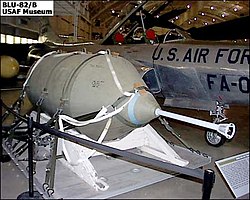BLU-82
| BLU-82B/C-130 | |
|---|---|
 A 15,000 lb BLU-82/B on display at the National Museum of the United States Air Force | |
| Type | Air to surface conventional bomb[1] (parachute retarded) |
| Place of origin | United States |
| Service history | |
| Wars | War in Afghanistan |
| Production history | |
| No. built | 225[1] |
| Specifications | |
| Mass | 15,000 lb (6,800 kg)[1] |
| Length | 141.6 in (360 cm)[1] |
| Diameter | 56 in (140 cm)[1] |
| Filling | GSX Slurry |
| Filling weight | 12,600 lb (5,700 kg)[1] |
The BLU-82B/C-130 weapon system, known under program "Commando Vault" and nicknamed "
Overview
The designation "BLU" stands for Bomb Live Unit, as opposed to "BDU" (Bomb Dummy Units) used for practice. Originally designed to create an instant clearing in the jungles of Vietnam, the BLU-82B/C-130 was test-dropped there from a
Specifications
The BLU-82 uses
The warhead contains 12,600 pounds (5,700 kg) of low-cost GSX slurry (ammonium nitrate, aluminum powder and polystyrene).The Daisy Cutter has sometimes been incorrectly reported as a
The BLU-82 produces an overpressure of 1,000 pounds per square inch (6,900 kPa) near ground zero, tapering off as distance increases. It is detonated just above ground by a 38-inch (970 mm) fuze extender. This results in a maximum destruction at ground level without digging a crater.
Guidance
This system depends upon the accurate positioning of the aircraft by either a fixed ground radar or on-board navigation equipment. The ground radar controller, or aircrew navigator if applicable, is responsible for positioning the aircraft prior to final countdown and release. Primary aircrew considerations include accurate ballistic and wind computations provided by the navigator, and precision instrument flying with strict adherence to controller instructions. Due to its extremely powerful blast effects, the minimum safe altitude for releasing this weapon is 6,000 feet (1,800 m) above ground level (AGL).
Operations
The BLU-82 was originally designed to clear helicopter landing zones and artillery emplacements in Vietnam.[4] The first use of a BLU-82 occurred on 22 March 1970, when one was dropped north of Long Tieng, Laos during Campaign 139.[5]
During
South Vietnamese
Eleven BLU-82Bs were palletized and dropped in five night missions during the 1991 Gulf War,[8] all from Special Operations MC-130 Combat Talons.[9] The initial drop tested the ability of the bomb to clear or breach mine fields;[10] however, no reliable assessments of mine clearing effectiveness are publicly available. Later, bombs were dropped as much for their psychological effect as for their anti-personnel effects.[11] Due to the size of the conventional blast, a British SAS unit that witnessed the explosion mistakenly assumed the U.S. had used a nuclear weapon and radioed back to their headquarters exclaiming, "Sir, the blokes have just nuked Kuwait!".[12]
The U.S. Air Force dropped several BLU-82s during the campaign to destroy Taliban and al-Qaeda bases in Afghanistan to attack and demoralize personnel and to destroy cave complexes.[9] American forces began using the bomb in November 2001[13] and again a month later during the Battle of Tora Bora.[14] On 15 July 2008, airmen from the Duke Field 711th Special Operations Squadron, 919th Special Operations Wing dropped the last operational BLU-82 at the Utah Test and Training Range.[15]
See also
References
- ^ ISBN 978-0-13-144021-0. Retrieved 13 April 2017.
- ^ London, U.K.: Aeroplane, Fricker, John, Crosswind, October 2006, Volume 34, Number 10, No. 402, page 120.
- ^ Independent Online, Taliban downs US chopper, killing four, November 6, 2001
- ^ "Bomb Live Unit (BLU-82/B)".
- ISBN 0-87364-825-0, p. 256.
- ^ Hinh, Nguyen Duy. "Lam Son 719" (PDF). page 133. U.S. Army Center of Military History. Archived (PDF) from the original on October 18, 2016. Retrieved 15 October 2016.
- ^ Grandolini, Albert. "Cambodia, Part Two; 1954–1999". ACIG.org. Retrieved 6 February 2013.
- ^ "C-130s drop 15,000-pound bombs on Iraqis WAR IN THE GULF". tribunedigital-baltimoresun. February 12, 1991. Retrieved 2017-09-08.
- ^ a b Pike, John. "BLU-82B." Federation of American Scientists, 24 March 2004.
- ^ Craib, J. A. "Occasional Paper Series 1: Survey of Mine Clearance Technology." BARIC (Consultants) Ltd., September 1994.
- ^ Wolfowitz, Paul; Stufflebeem, John D. "September 11, 2001: Attack on America Archived September 7, 2006, at the Wayback Machine." Department of Defense News Briefing, 10 December 2001.
- ^ "Secret Warriors". Newsweek. 1991-06-16. Retrieved 2017-09-08.
- ^ U.S. using mammoth 'Daisy Cutter' bomb
- ^ Daisy-cutter deployed after bin Laden sighting
- ^ Nichols, Patrick (Captain, 919th Operations Group). "Duke Field Airmen Drop Last 15,000-Pound Bomb." Air Force Link (U.S. Air Force), 21 July 2008. Retrieved 18 March 2016
External links
- "Bomb Live Unit (BLU-82/B)." U.S. Air Force National Museum.
- Pike, John. "BLU-82B." Federation of American Scientists, 24 March 2004.
- "Daisy Cutter." 3D Animated Short Film by Enrique Garcia & Ruben Salazar ( SILVERSPACE ).


